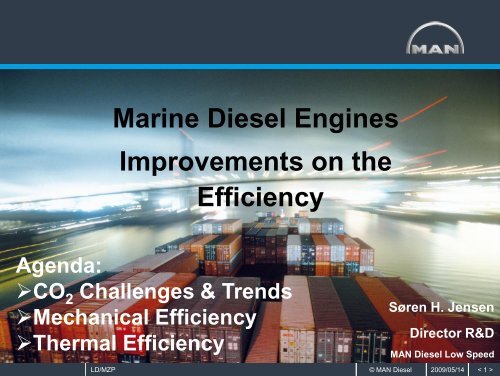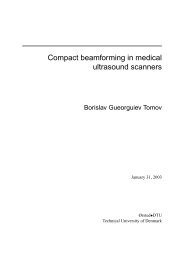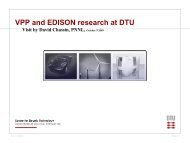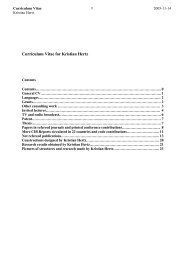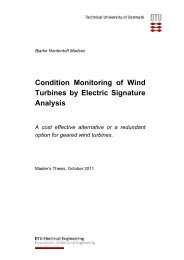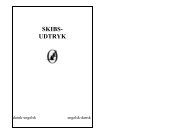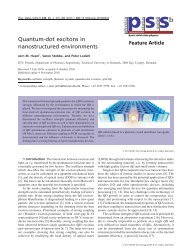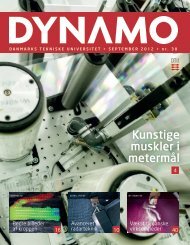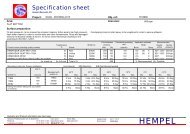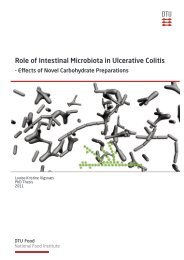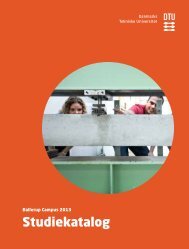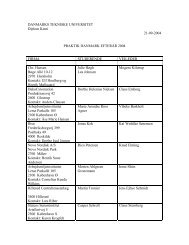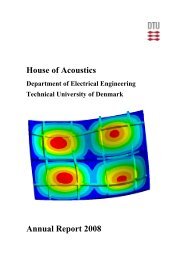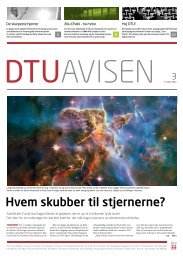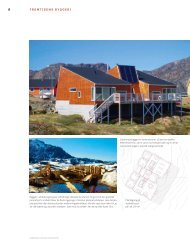Marine Diesel Engines Improvements on the Efficiency
Marine Diesel Engines Improvements on the Efficiency
Marine Diesel Engines Improvements on the Efficiency
Create successful ePaper yourself
Turn your PDF publications into a flip-book with our unique Google optimized e-Paper software.
<str<strong>on</strong>g>Marine</str<strong>on</strong>g> <str<strong>on</strong>g>Diesel</str<strong>on</strong>g> <str<strong>on</strong>g>Engines</str<strong>on</strong>g><br />
<str<strong>on</strong>g>Improvements</str<strong>on</strong>g> <strong>on</strong> <strong>the</strong><br />
<strong>Efficiency</strong><br />
Agenda:<br />
�CO 2 Challenges & Trends<br />
�Mechanical <strong>Efficiency</strong><br />
�Thermal <strong>Efficiency</strong><br />
Søren H. Jensen<br />
Director R&D<br />
MAN <str<strong>on</strong>g>Diesel</str<strong>on</strong>g> Low Speed<br />
LD/MZP CCCS workshop DTU © MAN <str<strong>on</strong>g>Diesel</str<strong>on</strong>g> 2009/05/28 2009/05/14 < 1 >
<str<strong>on</strong>g>Marine</str<strong>on</strong>g> Engine Programme 2009<br />
Two-stroke Propulsi<strong>on</strong> For Tier ll Compliance<br />
LD/MZP CCCS workshop DTU © MAN <str<strong>on</strong>g>Diesel</str<strong>on</strong>g> 2009/05/28 2
Huge Expansi<strong>on</strong> of Merchant<br />
Fleet - Many New Innovati<strong>on</strong>s<br />
6L60ME<br />
7S65ME-C<br />
7S60ME-C 2 x 6S70ME-C<br />
LD/MZP CCCS workshop DTU<br />
12K98MC<br />
© MAN <str<strong>on</strong>g>Diesel</str<strong>on</strong>g><br />
2009/05/28<br />
3
The Challenge: Emissi<strong>on</strong><br />
�Half of <strong>the</strong> world transport of goods is<br />
transported by MD two-stroke engines<br />
�MD has 15.000 engines in order or in<br />
operati<strong>on</strong><br />
�<str<strong>on</strong>g>Engines</str<strong>on</strong>g> with total power more than 200 GW<br />
– or equivalent to 20 times <strong>the</strong> Danish power<br />
plant supply!<br />
�The total fuel oil c<strong>on</strong>sumpti<strong>on</strong> is more than<br />
350 mill. t<strong>on</strong> yearly– about 3-4% of <strong>the</strong> world<br />
CO 2 emissi<strong>on</strong>!<br />
LD/MZP CCCS workshop DTU<br />
© MAN <str<strong>on</strong>g>Diesel</str<strong>on</strong>g><br />
2009/05/28<br />
4
CO 2 Emissi<strong>on</strong> compared with Different<br />
Means of Transportati<strong>on</strong><br />
Big tank ship<br />
Big c<strong>on</strong>tainer vessel<br />
Rail<br />
Coaster<br />
Truck<br />
Big van<br />
Flight<br />
0<br />
1<br />
3<br />
6<br />
11<br />
49<br />
100 200 300 400<br />
Kilde: Ministry of Land, Infrastructure and Transport (Japan): The Survey <strong>on</strong> Transport Energy 2001/2002<br />
MOL (Japan): Envir<strong>on</strong>mental and Social Report 2004<br />
LD/MZP CCCS workshop DTU © MAN <str<strong>on</strong>g>Diesel</str<strong>on</strong>g> 2009/05/28 < 5 ><br />
226<br />
398<br />
Units Relative
Emissi<strong>on</strong> Reducti<strong>on</strong><br />
Low Speed <str<strong>on</strong>g>Engines</str<strong>on</strong>g><br />
Ship Propulsi<strong>on</strong> Trends (CO2)<br />
• Super l<strong>on</strong>g stroke engines in c<strong>on</strong>tainer vessels.<br />
• Reduced speed to decrease fuel costs and CO 2<br />
emissi<strong>on</strong><br />
• Optimizati<strong>on</strong>s mechanically as well as <strong>the</strong>rmally<br />
• Waste Heat Recovery<br />
• LNG or LPG as engine fuels<br />
LD/MZP CCCS workshop DTU<br />
© MAN <str<strong>on</strong>g>Diesel</str<strong>on</strong>g><br />
2009/05/28<br />
6
Mechanical<br />
output: 48.5%<br />
History and Future for<br />
SFOC and NO x<br />
Standard Engine<br />
Energy in fuel: 100%<br />
Exh..gas 25.1%<br />
Charge air cooling: 17.8%<br />
Turbocharging:<br />
Before T/C : MEP ~ 6-7 bar, Pscav ~ 1.05-1.1 bar with Roots blowers<br />
Today : MEP ~ 20 bar , Pscav ~ 3.8-4 bar with turbochargers<br />
�SFOC = �CO 2 : -25 %<br />
Lub. oil cooling: 3.2%<br />
Jacket water cooling: 4.8%<br />
Radiati<strong>on</strong>: 0.6%<br />
LD/MZP CCCS workshop DTU<br />
© MAN <str<strong>on</strong>g>Diesel</str<strong>on</strong>g><br />
2009/05/28<br />
7
Thermal <strong>Efficiency</strong><br />
<str<strong>on</strong>g>Diesel</str<strong>on</strong>g> Working Cycle<br />
MAN B&W K98MC mk 7 PI = 20.2 bar 97 rpm Pmax = 151 bar<br />
Ideal heat release<br />
LD/MZP CCCS workshop DTU<br />
Ideal adiabatic process<br />
800<br />
bar<br />
Fuel injecti<strong>on</strong> pressure<br />
rate shaping<br />
350<br />
TDC 10 20<br />
Ideal scavenging<br />
© MAN <str<strong>on</strong>g>Diesel</str<strong>on</strong>g><br />
2009/05/28<br />
8
Propulsi<strong>on</strong> Optimizati<strong>on</strong><br />
The Tools<br />
Mechanical <strong>Efficiency</strong><br />
Advanced<br />
Materials, Fricti<strong>on</strong> &<br />
WP. 7<br />
ADVANCED MATERIALS,<br />
FRICTION AND WEAR<br />
Electr<strong>on</strong>ics<br />
and C<strong>on</strong>trol<br />
WP. 8<br />
ELECTRONICS<br />
AND CONTROL<br />
Wear<br />
WP. 1<br />
EXTREME PARAMETER<br />
ENGINES<br />
LD/MZP CCCS workshop DTU<br />
Overall<br />
Ship Powertrain Optimizati<strong>on</strong><br />
WP. 6<br />
OVERALL<br />
SHIP POWERTRAIN OPTIMIZATION<br />
Extreme Parameter<br />
<str<strong>on</strong>g>Engines</str<strong>on</strong>g><br />
Combusti<strong>on</strong><br />
WP. 2<br />
COMBUSTION<br />
Exhaust Emissi<strong>on</strong><br />
Reducti<strong>on</strong><br />
WP. 5<br />
EXHAUST EMISSION<br />
REDUCTION<br />
WP. 3<br />
TURBOCHARGING<br />
Turbocharging<br />
Thermal <strong>Efficiency</strong><br />
© MAN <str<strong>on</strong>g>Diesel</str<strong>on</strong>g><br />
2009/05/28<br />
< 9 >
Mechanical <strong>Efficiency</strong><br />
Powertrain Optimizati<strong>on</strong><br />
8000 teu c<strong>on</strong>tainer vessel: ME selecti<strong>on</strong> for reduced ship speeds/SMCR<br />
Derated 9S90ME-C8 versus 10K98ME7 and 12K98ME-C7<br />
LD/MZP CCCS workshop DTU<br />
© MAN <str<strong>on</strong>g>Diesel</str<strong>on</strong>g><br />
2009/05/28<br />
10
Mechanical <strong>Efficiency</strong><br />
Powertrain Optimizati<strong>on</strong><br />
8000 teu c<strong>on</strong>tainer vessel: ME selecti<strong>on</strong> for reduced ship speeds/SMCR<br />
Derated 9S90ME-C8 versus 10K98ME7 and 12K98ME-C7<br />
LD/MZP CCCS workshop DTU<br />
© MAN <str<strong>on</strong>g>Diesel</str<strong>on</strong>g><br />
2009/05/28<br />
11
Mechanical <strong>Efficiency</strong><br />
Powertrain Optimizati<strong>on</strong> - Fricti<strong>on</strong><br />
LD/MZP CCCS workshop DTU<br />
Pist<strong>on</strong><br />
Cross head<br />
C<strong>on</strong>necting rod<br />
Crankshaft<br />
Fricti<strong>on</strong> Studies for 2-stroke Applicati<strong>on</strong>s<br />
Dominating Fricti<strong>on</strong> Losses:<br />
�Pist<strong>on</strong> Ring Package<br />
�Guide Shoe Bearing<br />
© MAN <str<strong>on</strong>g>Diesel</str<strong>on</strong>g><br />
2009/05/28<br />
12
Mechanical <strong>Efficiency</strong><br />
Low Fricti<strong>on</strong> Guide Shoe Bearings<br />
� Crosshead guide height/width: 5 3.2<br />
� Number of oil quills <strong>on</strong> guide<br />
plan reduced to <strong>on</strong>e<br />
� Fricti<strong>on</strong>al loss reduced by<br />
approx. 20%<br />
LD/MZP CCCS workshop DTU<br />
© MAN <str<strong>on</strong>g>Diesel</str<strong>on</strong>g><br />
2009/05/28<br />
13
Thermal <strong>Efficiency</strong><br />
Electr<strong>on</strong>ics & C<strong>on</strong>trol - Auto Tuning<br />
Auto Tuning Overall Benefits<br />
� Fuel oil c<strong>on</strong>sumpti<strong>on</strong><br />
Reducti<strong>on</strong> potential: 3 g/kWh<br />
Reducti<strong>on</strong> average: 1 g/kWh<br />
� Emissi<strong>on</strong><br />
Potential: 2% CO 2 reducti<strong>on</strong><br />
LD/MZP CCCS workshop DTU © MAN <str<strong>on</strong>g>Diesel</str<strong>on</strong>g> 2009/05/28 < 14 >
Thermal <strong>Efficiency</strong><br />
Part Load T/C Cut-out<br />
Exhaust gas receiver<br />
Cooler Cooler Cooler<br />
Scavenging air receiver<br />
LD/MZP CCCS workshop DTU<br />
T/C Cut-out:<br />
1 of T/C 1 T/C, → 15% VTA power, Technology <strong>on</strong>ly emergency<br />
1 2 T/C of 2 T/C, → 50% VTA power, Technology <strong>on</strong>ly emergency<br />
1 of 3 T/C, 66% power<br />
1 of 4 T/C, 75% power<br />
Potential �SFOC ≤ -5 g/kWh (3%)<br />
at part load<br />
© MAN <str<strong>on</strong>g>Diesel</str<strong>on</strong>g><br />
2009/05/28<br />
15
Thermal <strong>Efficiency</strong><br />
Part Load - Variable Turbine Area<br />
<str<strong>on</strong>g>Engines</str<strong>on</strong>g> with dynamic load optimizati<strong>on</strong> with<br />
<strong>the</strong> VTA c<strong>on</strong>cept<br />
• Scavenging air delivery to be optimized to demand for<br />
scavenging air precisely, steplessly and c<strong>on</strong>tinuously at<br />
all engine loads and speeds<br />
• VTA minimizes fuel c<strong>on</strong>sumpti<strong>on</strong> and exhaust<br />
emissi<strong>on</strong>s<br />
• Potential �SFOC ≤ -5 g/kWh (3%)<br />
LD/MZP CCCS workshop DTU<br />
© MAN <str<strong>on</strong>g>Diesel</str<strong>on</strong>g><br />
2009/05/28<br />
16
Mechanical<br />
output: 48.5%<br />
Thermal <strong>Efficiency</strong><br />
The WHR Principle<br />
Standard Engine<br />
Exh. gas 25.1%<br />
Charge air cooling: 17.8%<br />
Lub. oil cooling: 3.2%<br />
Jacket water cooling: 4.8%<br />
Radiati<strong>on</strong>: 0.6%<br />
LD/MZP CCCS workshop DTU<br />
Mechanical<br />
output: 47.9%<br />
Engine with WHR system<br />
WHR<br />
elec.<br />
output<br />
4.9%<br />
C<strong>on</strong>denser: 8.6%<br />
Exh. gas 14.7%<br />
Charge air cooling: 15.4%<br />
© MAN <str<strong>on</strong>g>Diesel</str<strong>on</strong>g><br />
Jacket water cooling: 4.7%<br />
Lub. oil cooling: 3.2%<br />
Radiati<strong>on</strong>: 0.6%<br />
Energy in fuel: 100%<br />
Energy in Power-Turbine fuel: 100% (PT) in parallel with main engine turbochargers<br />
and / or<br />
Steam Turbine (ST) utilizing heat in <strong>the</strong> exhaust gas after <strong>the</strong> turbochargers<br />
Up to approx. 10% MCR power can be obtained with full WHR system (PT+ST)<br />
η standard ≈ 50% → η WHR ≈ 55% → η WHR+SAM ≈ 59%<br />
2009/05/28<br />
17
Thermal <strong>Efficiency</strong><br />
The WHR Principle<br />
Reproduced with permissi<strong>on</strong> from OSS<br />
LD/MZP CCCS workshop DTU © MAN <str<strong>on</strong>g>Diesel</str<strong>on</strong>g> 2009/05/28 18
Thermal <strong>Efficiency</strong><br />
The WHR Principle<br />
Dual pressure WHR system based <strong>on</strong> MAN 6S80ME-C9 main engine<br />
(27.06 MW)<br />
P PT = 1390 kW (100%)<br />
n PT = 26900 1/min<br />
LD/MZP CCCS workshop DTU<br />
P ST = 1852 kW (100%)<br />
n ST = 11000 1/min<br />
Power Turbine<br />
Steam Turbine<br />
(MAN <str<strong>on</strong>g>Diesel</str<strong>on</strong>g>) (MAN Turbo)<br />
Gear Box 2<br />
Gear Box 1<br />
(Renk AG)<br />
(Renk AG)<br />
MARC_HRS Turbine Package<br />
K<strong>on</strong>densator<br />
Generator<br />
P el = 3 100 kW<br />
n G = 1 800 1/min<br />
© MAN <str<strong>on</strong>g>Diesel</str<strong>on</strong>g><br />
2009/05/28<br />
19
Thermal <strong>Efficiency</strong><br />
The WHR Principle<br />
� Size and cost are c<strong>on</strong>siderable<br />
� Installati<strong>on</strong> complicated<br />
� C<strong>on</strong>trol aspect<br />
� Maintenance Reproduced with permissi<strong>on</strong> from OSS<br />
LD/MZP CCCS workshop DTU © MAN <str<strong>on</strong>g>Diesel</str<strong>on</strong>g> 2009/05/28 20
Thermal <strong>Efficiency</strong><br />
Liquid Natural Gas as a Fuel<br />
CO 2 Generati<strong>on</strong>: Heavy Fuel Oil versus Liquid Natural Gas<br />
Heavy Fuel Oil (average from MD database)<br />
� Heat of combusti<strong>on</strong> (lower) 40000 kJ/kg<br />
� C, H 86 wt%, 10-14 wt%,<br />
� S,N,O 0-4 wt%<br />
� Thus, CO 2 generati<strong>on</strong>: 0.080 g CO 2/kJ<br />
Liquid Natural Gas (100% CH 4)<br />
� Heat of combusti<strong>on</strong> (lower) 50000 kJ/kg (Perry’s, 1984)<br />
� C, H 75 wt%, 25 wt%<br />
� Thus, CO 2 generati<strong>on</strong>: 0.055 g CO 2/kJ<br />
� Normal mix: 85% metan, 15% ethan, propan, butan<br />
Thus 30% lower CO2 emissi<strong>on</strong> with CH4 LD/MZP CCCS workshop DTU<br />
compared to HFO<br />
© MAN <str<strong>on</strong>g>Diesel</str<strong>on</strong>g><br />
2009/05/28<br />
21
Thermal <strong>Efficiency</strong><br />
Liquid Natural Gas as a Fuel<br />
Specificati<strong>on</strong> of ME-GI Engine<br />
- Engine Type : 7S70ME-GI (for LNG ship)<br />
- Engine Power : 22890 kW x 91 rpm<br />
- Fuel Type : Dual Fuel (Natural Gas + Pilot Oil)<br />
- Operati<strong>on</strong> Modes : 1) Fuel Oil Only Mode<br />
2) Minimum Fuel Mode<br />
3) Specified Gas Mode<br />
- SFOC (g/kWh) : Normal mix: 85% metan, 15% ethan, propan, butan<br />
Type<br />
Engine Load<br />
100% 90% 75% 50%<br />
Natural Gas 132.8 130.9 129.1 131.2<br />
Pilot Oil 13.5 13.3 13.1 13.4<br />
LD/MZP CCCS workshop DTU © MAN <str<strong>on</strong>g>Diesel</str<strong>on</strong>g> 2009/05/28 22
Thermal <strong>Efficiency</strong><br />
LNG as a Fuel for n<strong>on</strong>-LNGC<br />
Potential Issues with LNG:<br />
• LNG Tank Locati<strong>on</strong><br />
• LNG Tank Size & Type<br />
• Class & Safety<br />
• Handling of BOG<br />
• LNG Loading Facilities<br />
•Logistics of LNG<br />
LNG Drum<br />
LD/MZP CCCS workshop DTU<br />
Gas Treatment System<br />
HP Pump<br />
M<br />
Cool down & mini flow line<br />
PC<br />
NG Damper<br />
LNG Vaporizer<br />
PC<br />
© MAN <str<strong>on</strong>g>Diesel</str<strong>on</strong>g><br />
ME-GI<br />
Engine<br />
2009/05/28<br />
8<br />
< 23 >
<str<strong>on</strong>g>Marine</str<strong>on</strong>g> <str<strong>on</strong>g>Diesel</str<strong>on</strong>g> <str<strong>on</strong>g>Engines</str<strong>on</strong>g><br />
<str<strong>on</strong>g>Improvements</str<strong>on</strong>g> <strong>on</strong> <strong>the</strong><br />
<strong>Efficiency</strong><br />
Questi<strong>on</strong>s?<br />
Søren H. Jensen<br />
Director R&D<br />
MAN <str<strong>on</strong>g>Diesel</str<strong>on</strong>g> Low Speed<br />
LD/MZP CCCS workshop DTU © MAN <str<strong>on</strong>g>Diesel</str<strong>on</strong>g> 2009/05/28 2009/05/14 < 24 >


